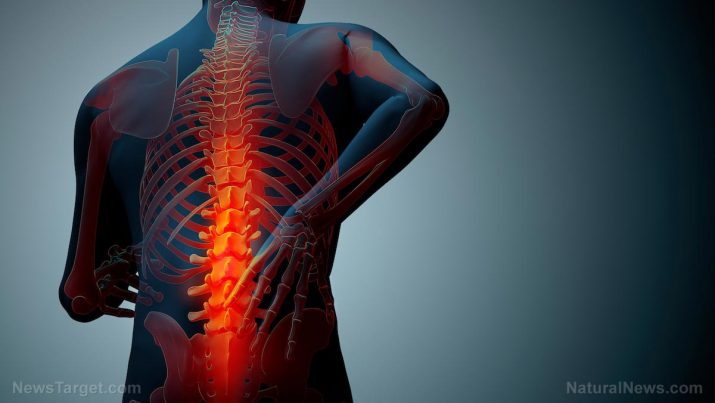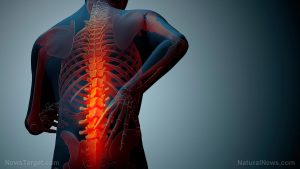
Lumbar Stenosis – causes, side effects and treatments at NaturalPedia.com
Thursday, May 17, 2018 by Zoey Sky
http://www.naturalpedia.com/lumbar-stenosis-causes-side-effects-and-treatments-at-naturalpedia-com.html

The spinal cord is a bundle of nerves that runs through a “tunnel” formed by the vertebrae. This tunnel is known as the spinal canal (vertebral foramen).
Lumbar stenosis refers to the narrowing of the spinal canal in the lower part of the back. “Stenosis” means narrowing, and this may cause pressure on the spinal cord or the nerves that are found from the spinal cord to the muscles.
Lumbar stenosis is also called lumbar spinal stenosis and spinal stenosis.

Known side effects of lumbar stenosis
The side effects of lumbar stenosis usually include:
- Loss of sensation in the legs and feet
- Low back pain
- Numbness
- Pain
- Weakness
Aging is a significant risk factor for lumbar spinal stenosis since it is linked to the degeneration of the spine. Osteoporosis is another less common risk factor for the condition since it may result in a compression fracture of the lumbar vertebrae, which then causes lumbar stenosis.
Body systems harmed by lumbar stenosis
Lumbar stenosis may occur anywhere along the spine, and it can cause various complications depending on where the narrowing occurs.
- Narrowing of the canal in the center of the spine – This can result in numbness, pain, or weakness in the arms and legs.
- Narrowing of canals on the bases of the vertebrae – This may spread to nerves leading from the spine and cause sciatica (radiating pain).
- Shrinking spaces between vertebrae – This can also affect nerves going to other body parts, and it can cause numbness, sciatica, and weakness.
Food items or nutrients that may prevent lumbar stenosis
The following foods or nutrients can help prevent lumbar stenosis and ease its side effects:
- Carbohydrates and fats – Maintaining a healthy weight can help relieve pressure on your back and minimize leg pain and numbness when doing normal activities. Keep your body energized by eating low-fat foods with complex carbohydrates like fruits and vegetables, oatmeal, and whole-wheat bread. Try to replace foods high in animal-based fats (e.g., butter) with foods that have plant-based fats, such as non-fat dairy products and olive oil.
- Fluids – Drinking enough water can help keep the spinal discs hydrated, which cushion the vertebrae and facilitate movement in the spinal joints. Drink at least eight glasses of water daily. Either limit or avoid your consumption of alcohol and caffeinated drinks that can make you dehydrated.
- Protein – The body needs protein to maintain muscle tissue, and the muscles and ligaments in your back help support and stabilize your spine and maintain correct posture. Proteins sources include beef, chicken, dairy products, eggs, fish, and nuts.
- Vitamins and minerals – Meet the daily requirements for essential vitamins and minerals to help minimize inflammation in the spine and minimize pain. Food products rich in vitamins A, C and D, B-complex vitamins, and calcium include beef, chicken, citrus fruits, dark green vegetables, eggs, fruits, milk, and orange and yellow vegetables.
Treatments, management plans for lumbar stenosis
Treatments for lumbar stenosis include pharmaceutical treatment and surgery.
First-line treatments for the condition involve medications that can help relieve pain. Cortisone injections into the spinal column can help minimize swelling. Nonsteroidal anti-inflammatory drugs (NSAIDs) can also help reduce pain. Physical therapy is another option that can help strengthen muscles and stretch a patient’s body.
Patients with lumbar stenosis who suffer from severe pain may require surgery. Surgery is also needed if an individual with the condition suffers from neurological loss. Surgery can relieve pressure permanently. These types of surgery are used to treat spinal stenosis:
- Foraminotomy – This surgery is performed to widen the part of the spine where the nerves exit.
- Laminectomy – The most common type of surgery. During a laminectomy, a surgeon removes part of the vertebrae to give the nerves more room.
- Spinal fusion – Usually done in more severe cases, a spinal fusion is required when multiple levels of the spine are involved. This surgery prevents instability, and it involves bone grafts or metal implants to fuse the affected bones of the spine.
Where to learn more
- 10 natural remedies for back pain
- The 5 Best Home Remedies for Joint Inflammation
- Improving your posture could help reduce muscle pain, joint pain and headaches
- Treating Lower Back Pain Without Surgery or Prescriptions
- Try These 3 Amazing Natural Killers for Chronic Pain
Summary
Lumbar stenosis refers to the narrowing of the spinal canal in the lower part of the back.
The side effects of lumbar stenosis usually include loss of sensation in the legs and feet, low back pain, numbness, pain, and weakness.
Aging is a major risk factor for lumbar spinal stenosis since it is linked to the degeneration of the spine.
Lumbar stenosis may occur anywhere along the spine, and it can cause various complications depending on where the narrowing occurs.
Carbohydrates and fats, fluids, protein, and vitamins and minerals can help prevent lumbar stenosis and ease its side effects.
Treatments for lumbar stenosis include pharmaceutical treatment and surgery.
Sources include
Tagged Under: Tags: lumbar stenosis





